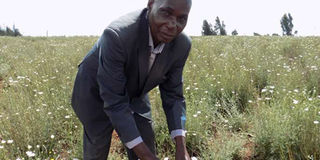Why I’ll stick with pyrethrum forever, no matter what

Omweri tends his pyrethrum crops. PHOTO|RACHEL KIBUI
What you need to know:
- John Omweri has grown pyrethrum since the 70s and has never abandoned the crop even during the difficult times
- The crops are the mainstay for farmers in the region that records bumper harvest for most of the seasons due to a good climate and fertile soil
- Requires minimal labour and no fertiliser or chemicals, which makes it profitable
- Earns between Sh140-Sh221 per kilo
A chilly weather bites as I make my way to Muchorue market in Molo.
At the market, some traders are washing carrots and potatoes, ready for ferrying to markets in Nakuru and Nairobi while others are selling garden peas and cabbages.
The crops are the mainstay for farmers in the region that records bumper harvest for most of the seasons due to a good climate and fertile soil.
Years back, pyrethrum outshone the food crops on the region’s farms, but not any more as poor market made farmers ditch the cash crop.
However, as the majority trooped to the food crops, a few like John Omweri have stuck to pyrethrum.
His farm along Molo-Olenguruone Road stands out so it is not difficult to trace. In the region, he is known as the ‘Pyrethrum Man’.
PYRETHRUM FARMER
“I have been a pyrethrum farmer since the 70s and I am not planning to stop growing the crop any sooner,” says the 62-year-old.
Farmers abandoned the crop in the early 2000 when Pyrethrum Board of Kenya (PBK) started delaying payments, but Omweri has always had pyrethrum on his farm.
Pyrethrum, he says, has no season and is picked throughout the year unlike other crops, which solely thrive during the rainy season.
“Pyrethrum is also not affected by diseases such as potato blight, which often cause hefty losses to farmers,” says Omweri, adding, “It also requires minimal labour and no fertiliser or chemicals,
which makes it profitable.”
He is among the few farmers with the highest acreage of the crop in the region, having dedicated six acres for it.
“I love the fact that I invest little and earn so much. And there is little competition since not many farmers grow the crop, which gives me an edge.”
To grow pyrethrum, one plants a clone, waits for three months and starts picking flowers. The plant is cut off after every three years to sprout again. Frequent weeding is vital for a healthy crop,
thus bumper harvest.
Omweri hires labour only when he wants to weed and harvest. He picks flowers after every two weeks, harvesting an average of 60kg of dried flowers per acre.
While he spends Sh4,000 monthly on labour per acre, Omweri says he earns between Sh140-Sh221 per kilo from the same piece of land, depending on where he sells his flowers.
Unlike before, when he only depended on PBK for market, HighChem, a new company, offers a ready and competitive market for his produce.
Currently, Highchem is buying his dried flowers at Sh140 per kilo while PBK is taking the same amount for Sh221.
“PBK had for long been buying for Sh100 a kilo but they started hiking prices due to competition. I sell my produce to the highest bidder.”
THRIVING INDUSTRY
Pyrethrum, Omweri says, has helped him construct a three-bedroom house, educate his six children, some to university level and buy 10 acres in Elburgon.
Pyrethrum was a thriving industry between the 1960s and the 1990s when Kenya commanded 90 percent of the world’s market.
According to a 2014 report by Pyrethrum Growers Association, Kenya’s production fell by 91 per cent between 2003 and 2011.
“Kenya now commands less than two percent of the world’s market,” reads the report.
In mid-1990’s, according to the document, Kenya had over 220,000 farmers against an estimated 7,000-12,000 in 2014.
Omweri notes those who abandoned the crop were impatient and lacked optimism.
“Everything has its lows and highs,” he says, adding that only patient and hopeful farmers can farm the crop.
For Omweri, it is pyrethrum forever, as he has cushioned himself from delayed payments if they happen. All he does, he says, is to manage his money when he gets paid.
EMBRACE THE CROP
Besides, he keeps sheep, which compliments his earnings from pyrethrum farming.
Nakuru County Government Agriculture Committee Member Njuguna Gichamu says there is hope for pyrethrum industry if only farmers embrace the crop.
The county government, he adds, has been working towards reviving the industry through establishment of seed multiplication nurseries and distribution to farmers.
“We have the responsibility of marketing pyrethrum, but we can only do so if there is good supply and this can only be enhanced if farmers embraced this cash crop.”
Pyrethrum, according to Gichamu, offers frequent income, unlike potatoes, peas and other food crops, which are harvested once after every three months.





